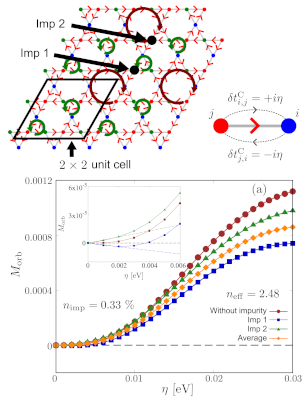Giant impurity effects on charge loop current order states in kagome metals
S. Nakazawa, R. Tazai, Y. Yamakawa, S. Onari, and H. Kontani,
Phys. Rev. B 111, 075161 (2025).
Published 25 February, 2025
The exotic electronic states in the charge loop current (cLC) phase, in which the permanent charge current breaks the time-reversal symmetry, have been attracting increasing attention in recently discovered kagome metals AV3Sb5 (A=Cs,Rb,K). Interestingly, the cLC state is sensitively controlled by applying a small magnetic field as well as a tiny uniaxial strain. In addition, many experiments indicate that the cLC state is sensitive to the small number of impurities. To understand the impurity effects on the cLC electronic states accurately, we analyze the giant unit-cell (up to 1200 sites) kagome lattice model with single impurity potential. The loop current is found to be strongly suppressed within the current correlation length ξJ centered on the impurity site, where ξJ increases as the cLC order parameter η decreases. (The cLC order is the pure imaginary hopping integral modulation δti,j = ±iη.) In addition, both the uniform orbital magnetization Morb and the anomalous Hall conductivity σxy are drastically suppressed by dilute impurities. Especially, the suppression ratio R = ΔMorb/M0orb can exceed 50% with the introduction of ∼1% impurities. Unexpectedly, the ratio R is qualitatively insensitive to η, in high contrast to a naive expectation that R is proportional to the current suppression area πξJ2. The resulting giant impurity effect of Morb originates from the nonlocal contribution of the itinerant circulation of electrons. The present study gives a natural explanation of why the cLC electronic states in kagome metals are sensitive to dilute impurities.
(Click figure for a larger image.)

